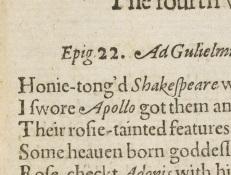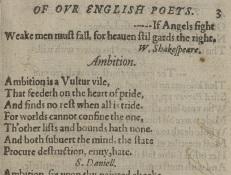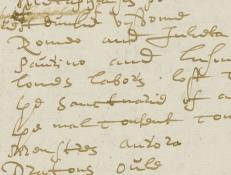To view a sortable list, please visit the Resource
All Documents
1597
Romeo and Juliet was one of Shakespeare’s most popular plays from the moment it was first performed and printed.
1599
Customers browsing in the bookshops of London in 1599 would have found a new version of a popular play based on the well-known story of Romeo and Juliet.
1599
SHAKESPEARE DOCUMENTED IS STILL GROWING! Descriptive content and transcriptions will continue to be added, updated and expanded. Check back for regular updates!
1599
John Weever’s Epigrammes in the oldest cut, and newest fashion was published in 1599. Weever began his career as an aspiring poet and literary observer at Cambridge, where he was the student of William Covell at Queen’s College.
1600
Like other plays from the period, Shakespeare's plays were meant to be read both as stories and as sources for sententiae, or memorable aphorisms.
1600
Englands Parnassus is one of two printed commonplace books, or collections of extracts organized by topic, compiled by Robert Allott, and was printed shortly after John Bodenham’s Bel-vedére.
ca. 1600-1615
SHAKESPEARE DOCUMENTED IS STILL GROWING! Descriptive content and transcriptions will continue to be added, updated and expanded. Check back for regular updates!
1598- 1601
SHAKESPEARE DOCUMENTED IS STILL GROWING! Descriptive content and transcriptions will continue to be added, updated and expanded. Check back for regular updates!
1606
SHAKESPEARE DOCUMENTED IS STILL GROWING! Descriptive content and transcriptions will continue to be added, updated and expanded. Check back for regular updates!
January 22, 1607
On January 22, 1607, publisher Cuthbert Burby transferred Romeo and Juliet, Love's Labor's Lost, and The Taming of the Shrew to fellow publisher Nicholas Ling in an entry in Liber C of the Stationers' Company.















